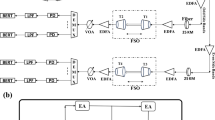Abstract
In this paper, the improvement in dispersion tolerance of high-speed transmission link with directly modulated laser is presented. The method is based on adopting the laser modulation (its amplitude and depth) accordingly to the dispersion of actual link. As it is shown, the tolerance of negative dispersion may be doubled and of positive increased even seven times. The simulations are proved by hardware experiment, in which the extended dispersion tolerance is demonstrated.
Similar content being viewed by others
References
S. Mohrdiek, H. Burkhard, F. Steinhagen, H. Hilmer, R. Losch, W. Schlapp, and R. Gobel, “10-Gb/s standard fiber transmission using directly modulated 1.55-μm quantum—well DFB lasers”, IEEE Photonic. Tech. L. 7, 1357–1359 (1995).
I. Tomkos, B. Hallock, I. Roudas, R. Hesse, A. Boskovic, and R. Vodhanel, “10-Gb/s transmission of 1.55-μm directly modulated signal over 100 km of negative dispersion fiber”, IEEE Photonic. Tech. L. 13, 735–737 (2001).
P. Krehlik, “Directly modulated lasers in chromatic dispersion limited 10 Gb/s links”, Electronics and Telecommunications Quarterly 53, 177–191 (2007).
P. Krehlik, “Directly modulated lasers in negative dispersion fiber links”, Opto-Electron. Rev. 15, 71–77 (2007).
G.P. Agrawal and N.K. Dutta, Long-wavelength Semicon-ductor Lasers, Van Nostrand Reinhold, 1993.
I. Tomkos, I. Roudas, A. Boskovic, R. Hesse, N. Antoniades, and R. Vodhanel, “Measurements of laser rate equations parameters for representative simulations of metropolitan-area transmission systems and networks”, Opt. Commun. 194, 109–129 (2001).
P. Krehlik, “Characterization of semiconductor laser frequency chirp based on signal distortion in dispersive optical fiber”, Opto-Electron. Rev. 14, 123–128 (2006).
K. Sato, S. Kuwahara, and Y. Miyamoto, “Chirp characteristics of 40-Gb/s directly modulated distributed-feedback laser diodes”, J. Lightwave Techn. 23, 3790–3797 (2005).
L. Bjerkan, A. Royset, L. Hafskjaer, and D. Myhre, “Measurement of laser parameters for simulation of high-speed fiberoptic systems”, J. Lightwave Techn. 14, 839–850 (1996).
B.E.A. Saleh and M.C. Teich, Fundamentals of Photonics, Wiley, 1991.
G.P. Agrawal, Nonlinear Fiber Optics, Academic Press Inc., 2001.
Corning MetroCor Fiber and its Applications in Metropolitan Networks, Corning Incorporated White Paper, 2000.
ITU-T 959.1 Recommendation on Optical Transport Network Physical Layer Interfaces, ITU, 2003.
IEEE 802.ae Amendment to Standard 803.3, IEEE, 2002.
Author information
Authors and Affiliations
Corresponding author
About this article
Cite this article
Krehlik, P. Improvement in dispersion tolerance of high-speed fiber optic transmission link by optimization of laser modulation. Opto-Electron. Rev. 17, 225–230 (2009). https://doi.org/10.2478/s11772-009-0006-y
Published:
Issue Date:
DOI: https://doi.org/10.2478/s11772-009-0006-y




